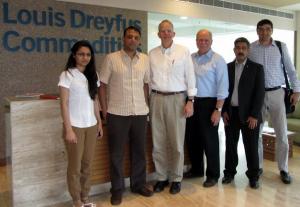“India may be the most complex market we have ever worked in,” said U.S. Grains Council President and CEO Tom Sleight at the conclusion of his recent visit to the country. “We need to develop a consistent, strategic vision and plan to guide our appropriate level of engagement in India. Whatever happens in India, it will be a major player in the future of global food demand. We must resist over-valuing the India, just as we must resist undervaluing our engagement.”
Sleight and a small team of USGC staff visited India April 14-20 to get a firsthand look at this vibrant, demographically young and growing country. The team’s schedule included traders, poultry and dairy companies, U.S. embassy officials, and leaders of industry associations in New Delhi and Bangalore.
The team met a highly experienced group of industry leaders. They have skills and knowledge. They are creative and aware of global developments. The team also saw huge numbers of young, educated and well-dressed workers in vast Information Technology centers. Yet despite the obvious rapid pace of modernization, the country’s unique ways of doing business, complexity of government policy making, and traditions that direct consumer preferences all combine to make India a great puzzle.
Sleight and his team concluded that Indian culture and traditions will not stifle demand growth or changes in food preferences. But culture and tradition likely will baffle outside observers who try to map that growth by drawing broad conclusions from desktop analysis. Even in India the future is hard to see. In response to the question ‘When will India become a corn importer?’ the team received the following answers: “Two years.” “Five years.” “Seven years.” “Ten years.” “Don’t hold your breath.”
‘India is changing – but slowly,’ said one observer. And as those changes move India toward a greater participation in global food markets the U.S. Grains Council has a role to play. The Council already has a strong, positive reputation as a result of its past involvement with poultry, dairy and trade sector leaders. “Our involvement in India needs to be that of a facilitator,” said Sleight. He observed that our Indian partners have the skills and capabilities and resources they need, but look to the Council as a catalyst for stimulating cooperation among Indian players to bring change on larger scale.
“Partnership is the key in India,” said Sleight. The Council will build on its established partnerships with industry, associations and with the U.S. Agricultural Counselor and his staff. “The Council needs to stay involved in India, but must follow an appropriate plan – not too fast, not too slow, well-conceived and strategic.”


